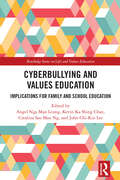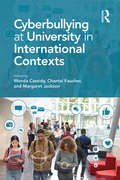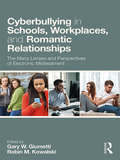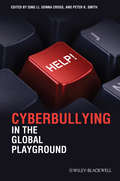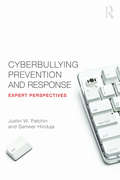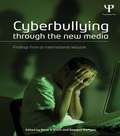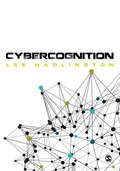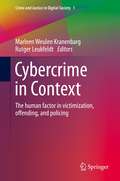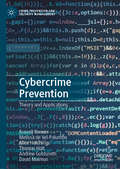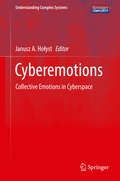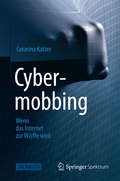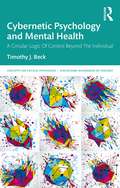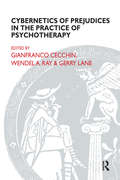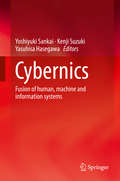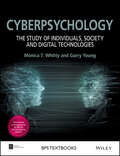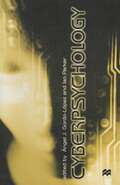- Table View
- List View
Cyberbullying and Values Education: Implications for Family and School Education (Routledge Series on Life and Values Education)
by Angel Nga Man Leung Kevin Ka Shing Chan Catalina Sau Man Ng John Chi-Kin LeeWritten by scholars from both the Western and Chinese contexts, this monograph discusses the relation between cyberbullying and socio-emotional-moral competencies, feasible interventions by integrating values education, and provides future directions in the field of cyberpsychology. Cyberbullying has become a growing concern in the digital age as it brings devastating impacts on its victims. Educating the younger generation, particularly through values education, also known as character, moral, or social-emotional learning, helps equip children and adolescents with the necessary ethical and moral attitudes, and foster the necessary socio-emotional competencies for them to navigate the digital world as responsible cyber-citizens. A central focus of the book is intervention and education. Cultivating competences and responsible use of technology in the younger generation through values education and evidence-based intervention helps combat cyberbullying. Families, schools, and communities can work together with suitable school programs, teacher education, and parents/school collaboration to help students cope with cyberbullying and create safer online spaces for them. Technology itself is not inherently good or bad but shaped by human choices and values. Supported by empirical evidence and theoretical insights, this book suggests ways to promote moral and emotional skills, foster digital citizenship, and encourage ethical technology design. This book provides a comprehensive understanding of cyberbullying. This timely resource will contribute to creating a safer and more positive online environment for all. It will inform researchers, educators, parents, and the community in combating cyberbullying by enabling children and adolescents to be responsible, ethical, and happy netizens.
Cyberbullying at University in International Contexts
by Wanda Cassidy Chantal Faucher Margaret JacksonCyberbullying is a problem that is being increasingly investigated by researchers, however, much of the cyberbullying research literature to date has focused on children and youth. Cyberbullying at University in International Contexts fills the gap in the research literature by examining the nature, extent, impacts, proposed solutions, and policy and practice considerations of bullying in the cyber-world at post-secondary institutions, where reports of serious cyberbullying incidents have become more prevalent. This book brings together cutting-edge research from around the world to examine the issue of cyberbullying through a multi-disciplinary lens, offering an array of approaches, interpretations, and solutions. It is not solely focused on cyberbullying by and against students, but also includes cyberbullying by and against faculty members, and permutations involving both students and faculty, as well as institutional staff, presenting perspectives from students, practitioners and senior university policy makers. It draws on research from education, criminology, psychology, sociology, communications, law, health sciences, social work, humanities, labour studies and is valuable reading for graduate students in these fields. It is also essential reading for policymakers, practitioners and University administrators who recognize their responsibility to provide a healthy workplace for their staff, as well as a safe and respectful environment for their students.
Cyberbullying at University in International Contexts
by Wanda Cassidy Chantal Faucher Margaret JacksonCyberbullying is a problem that is being increasingly investigated by researchers, however, much of the cyberbullying research literature to date has focused on children and youth. Cyberbullying at University in International Contexts fills the gap in the research literature by examining the nature, extent, impacts, proposed solutions, and policy and practice considerations of bullying in the cyber-world at post-secondary institutions, where reports of serious cyberbullying incidents have become more prevalent. This book brings together cutting-edge research from around the world to examine the issue of cyberbullying through a multi-disciplinary lens, offering an array of approaches, interpretations, and solutions. It is not solely focused on cyberbullying by and against students, but also includes cyberbullying by and against faculty members, and permutations involving both students and faculty, as well as institutional staff, presenting perspectives from students, practitioners and senior university policy makers. It draws on research from education, criminology, psychology, sociology, communications, law, health sciences, social work, humanities, labour studies and is valuable reading for graduate students in these fields. It is also essential reading for policymakers, practitioners and University administrators who recognize their responsibility to provide a healthy workplace for their staff, as well as a safe and respectful environment for their students.
Cyberbullying in Schools, Workplaces, and Romantic Relationships: The Many Lenses and Perspectives of Electronic Mistreatment
by Gary W. Giumetti Robin M. KowalskiThis volume brings together research on cyberbullying across contexts, age groups, and cultures to gain a fuller perspective of the prevalence and impact of electronic mistreatment on individual, group, and organizational outcomes. This is the first book to integrate research on cyberbullying across three contexts: schools, workplaces, and romantic relationships, providing a unique synthesis of lifespan contexts.For each context, the expert chapter authors bring together three different 'lenses': existing research on the predictors and outcomes of cyberbullying within that context; a cross-cultural review across national borders and cultural boundaries; and a developmental perspective that examines age-related differences in cyberbullying within that context. The book closes by drawing commonalities across these different contexts leading to a richer understanding of cyberbullying as a whole and some possible avenues for future research and practice.This is fascinating reading for researchers and upper-level students in social psychology, counseling, school psychology, industrial-organizational psychology, and developmental psychology, as well as educators and administrators.
Cyberbullying in Schools, Workplaces, and Romantic Relationships: The Many Lenses and Perspectives of Electronic Mistreatment
by Gary W. Giumetti Robin M. KowalskiThis volume brings together research on cyberbullying across contexts, age groups, and cultures to gain a fuller perspective of the prevalence and impact of electronic mistreatment on individual, group, and organizational outcomes. This is the first book to integrate research on cyberbullying across three contexts: schools, workplaces, and romantic relationships, providing a unique synthesis of lifespan contexts.For each context, the expert chapter authors bring together three different 'lenses': existing research on the predictors and outcomes of cyberbullying within that context; a cross-cultural review across national borders and cultural boundaries; and a developmental perspective that examines age-related differences in cyberbullying within that context. The book closes by drawing commonalities across these different contexts leading to a richer understanding of cyberbullying as a whole and some possible avenues for future research and practice.This is fascinating reading for researchers and upper-level students in social psychology, counseling, school psychology, industrial-organizational psychology, and developmental psychology, as well as educators and administrators.
Cyberbullying in the Global Playground: Research from International Perspectives
by Qing Li Donna Cross Peter K. SmithCyberbullying in the Global Playground provides the first global, in-depth analysis of the emerging phenomenon of cyberbullying. Offers the first thorough comparative account of recent research into the emerging global phenomenon of cyberbullying Provides an international perspective on the prevalence and nature of cyberbullying Presents recent authoritative research within a critical perspective, drawing out theoretical and practical implications for policy and practice May be used to help design intervention, evaluation, and policy strategies for effective efforts to combat the international phenomenon of cyberbullying
Cyberbullying in the Global Playground: Research from International Perspectives
by Qing Li Donna Cross Peter K. SmithCyberbullying in the Global Playground provides the first global, in-depth analysis of the emerging phenomenon of cyberbullying. Offers the first thorough comparative account of recent research into the emerging global phenomenon of cyberbullying Provides an international perspective on the prevalence and nature of cyberbullying Presents recent authoritative research within a critical perspective, drawing out theoretical and practical implications for policy and practice May be used to help design intervention, evaluation, and policy strategies for effective efforts to combat the international phenomenon of cyberbullying
Cyberbullying Prevention and Response: Expert Perspectives
by Justin W. Patchin Sameer HindujaJust as the previous generation was raised in front of televisions, adolescents at the turn of the 21st century are being raised in an internet-enabled world where blogs, social networking, and instant messaging are competing with face-to-face and telephone communication as the dominant means through which personal interaction takes place. Unfortunately, a small but growing proportion of our youth are being exposed online to interpersonal violence, aggression, and harassment via cyberbullying. The mission of this book is to explore the many critical issues surrounding this new phenomenon. Key features include the following. Comprehensive – The book provides a comprehensive, up-to-date look at the major issues that teachers, school administrators, counsellors, social workers, and parents need to be aware of with respect to cyberbullying identification, prevention, and response. Practical – While the information is informed by research, it is written in an accessible way that all adults will be able to understand and apply. Expertise – Justin W. Patchin and Sameer Hinduja are Co-Directors of the Cyberbullying Research Center (www.cyberbullying.us). Chapter authors represent a carefully selected group of contributors who have demonstrated both topical expertise and an ability to write about the topic in clear, easily accessible language. This book is appropriate for teachers, administrators, parents and others seeking research-based guidance on how to deal with the rising tide of cyberbullying issues. It is also appropriate for a variety of college level courses dealing with school violence and educational administration.
Cyberbullying Prevention and Response: Expert Perspectives
by Justin W. Patchin Sameer HindujaJust as the previous generation was raised in front of televisions, adolescents at the turn of the 21st century are being raised in an internet-enabled world where blogs, social networking, and instant messaging are competing with face-to-face and telephone communication as the dominant means through which personal interaction takes place. Unfortunately, a small but growing proportion of our youth are being exposed online to interpersonal violence, aggression, and harassment via cyberbullying. The mission of this book is to explore the many critical issues surrounding this new phenomenon. Key features include the following. Comprehensive – The book provides a comprehensive, up-to-date look at the major issues that teachers, school administrators, counsellors, social workers, and parents need to be aware of with respect to cyberbullying identification, prevention, and response. Practical – While the information is informed by research, it is written in an accessible way that all adults will be able to understand and apply. Expertise – Justin W. Patchin and Sameer Hinduja are Co-Directors of the Cyberbullying Research Center (www.cyberbullying.us). Chapter authors represent a carefully selected group of contributors who have demonstrated both topical expertise and an ability to write about the topic in clear, easily accessible language. This book is appropriate for teachers, administrators, parents and others seeking research-based guidance on how to deal with the rising tide of cyberbullying issues. It is also appropriate for a variety of college level courses dealing with school violence and educational administration.
Cyberbullying through the New Media: Findings from an international network
by Peter K. Smith Georges SteffgenCyberbullying is one of the darker and more troubling aspects to the growing accessibility of new media technologies. Children in developed countries engage with cyberspace at younger and younger ages, and the use of the internet as a means to bully and harass has been greeted with alarm by educationalists, parents, the media, and governments. This important new book is the result of a four-year international collaboration, funded by the EU, to better understand how we can cope and confront cyberbullying, and how new media technologies can be used to actually support the victims of such abuse. The articles initially define the historical and theoretical context to cyberbullying, before examining key issues involved in managing this pervasive phenomenon. Coverage includes: The definition and measurement of cyberbullying. The legal challenges in tackling cyberbullying across a number of international contexts. The role of mobile phone companies and Internet service providers in monitoring and prevention How the media frame and present the issue, and how that influences our understanding. How victims can cope with the effects of cyberbullying, and the guidelines and advice provided in different countries. How cyber-bullying can continue from school into further education, and the strategies that can be used to prevent it. The ways in which accessing 'youth voice', or maximising the contribution of young people themselves to the research process, can enhance our understanding The book concludes with practical guidance to help confront the trauma that cyberbullying can cause. It will be a valuable resource for researchers, students, policy makers and administrators with an interest in how children and young people are rendered vulnerable to bullying and harassment through a variety of online channels.
Cyberbullying through the New Media: Findings from an international network
by Peter K. Smith Georges SteffgenCyberbullying is one of the darker and more troubling aspects to the growing accessibility of new media technologies. Children in developed countries engage with cyberspace at younger and younger ages, and the use of the internet as a means to bully and harass has been greeted with alarm by educationalists, parents, the media, and governments. This important new book is the result of a four-year international collaboration, funded by the EU, to better understand how we can cope and confront cyberbullying, and how new media technologies can be used to actually support the victims of such abuse. The articles initially define the historical and theoretical context to cyberbullying, before examining key issues involved in managing this pervasive phenomenon. Coverage includes: The definition and measurement of cyberbullying. The legal challenges in tackling cyberbullying across a number of international contexts. The role of mobile phone companies and Internet service providers in monitoring and prevention How the media frame and present the issue, and how that influences our understanding. How victims can cope with the effects of cyberbullying, and the guidelines and advice provided in different countries. How cyber-bullying can continue from school into further education, and the strategies that can be used to prevent it. The ways in which accessing 'youth voice', or maximising the contribution of young people themselves to the research process, can enhance our understanding The book concludes with practical guidance to help confront the trauma that cyberbullying can cause. It will be a valuable resource for researchers, students, policy makers and administrators with an interest in how children and young people are rendered vulnerable to bullying and harassment through a variety of online channels.
Cybercognition: Brain, behaviour and the digital world (PDF)
by Dr Lee HadlingtonTechnology is developing rapidly. It is an essential part of how we live our daily lives – in a mental and physical sense, and in professional and personal environments. Cybercognition explores the ideas of technology addiction, brain training and much more, and will provide students with a guide to understanding concepts related to the online world. It answers important questions: What is the impact of digital technology on our learning, memory, attention, problem-solving and decision making? If we continue to use digital technology on a large scale, can it change the way we think? Can human cognition keep up with technology? Suitable for students on Cyberpsychology and Cognitive Psychology courses at all levels, as well as anyone with an inquiring mind.
Cybercognition: Brain, behaviour and the digital world
by Dr Lee HadlingtonTechnology is developing rapidly. It is an essential part of how we live our daily lives – in a mental and physical sense, and in professional and personal environments. Cybercognition explores the ideas of technology addiction, brain training and much more, and will provide students with a guide to understanding concepts related to the online world. It answers important questions: What is the impact of digital technology on our learning, memory, attention, problem-solving and decision making? If we continue to use digital technology on a large scale, can it change the way we think? Can human cognition keep up with technology? Suitable for students on Cyberpsychology and Cognitive Psychology courses at all levels, as well as anyone with an inquiring mind.
Cybercrime in Context: The human factor in victimization, offending, and policing (Crime and Justice in Digital Society #I)
by Rutger Leukfeldt Marleen Weulen KranenbargThis book is about the human factor in cybercrime: its offenders, victims and parties involved in tackling cybercrime. It takes a diverse international perspective of the response to and prevention of cybercrime by seeking to understand not just the technological, but the human decision-making involved. This edited volume represents the state of the art of research on the human factor in cybercrime, addressing its victims, offenders, and policing. It originated at the Second annual Conference on the Human Factor in Cybercrime, held in The Netherlands in October 2019, bringing together empirical research from a variety of disciplines, and theoretical and methodological approaches. This volume will be of particular interest to researchers and students in cybercrime and the psychology of cybercrime, as well as policy makers and law enforcement interested in prevention and detection.
Cybercrime Prevention: Theory and Applications (Crime Prevention and Security Management)
by Russell Brewer Melissa de Vel-Palumbo Alice Hutchings Thomas Holt Andrew Goldsmith David MaimonThis book articulates how crime prevention research and practice can be reimagined for an increasingly digital world. This ground-breaking work explores how criminology can apply longstanding, traditional crime prevention techniques to the digital realm. It provides an overview of the key principles, concepts and research literature associated with crime prevention, and discusses the interventions most commonly applied to crime problems. The authors review the theoretical underpinnings of these and analyses evidence for their efficacy. Cybercrime Prevention is split into three sections which examine primary prevention, secondary prevention and tertiary prevention. It provides a thorough discussion of what works and what does not, and offers a formulaic account of how traditional crime prevention interventions can be reimagined to apply to the digital realm.
Cyberemotions: Collective Emotions in Cyberspace (Understanding Complex Systems)
by Janusz A. HolystThis first monograph of its kind introduces the reader to fundamental definitions, key concepts and case studies addressing the following issues of rapidly growing relevance for online communities: What are emotions? How do they emerge, how are they transmitted? How can one measure emotional states? What are cyberemotions? When do emotions and cyberemotions become collective phenomena? How can one model emotions and their changes? What role do emotions play for on-line communities?Edited and authored by leading scientists in this field, this book is a comprehensive reference for anyone working on applications of complex systems methods in the social sciences, as well as for social scientists, psychologists, experts in on-line communities and computer scientists.This book provides an excellent overview of the current state-of-art in research on collective emotional interactions mediated by the Internet. It introduces a reader in social phenomena occurring in cyberspace, algorithms needed for automatic sentiment detection and data driven modeling of emotional patterns observed in on-line groups.Eugene Stanley, Professor, Boston UniversityWith the explosive hyper-exponential growth of the internet suddenly new ways of communication are emerging that give rise to a digital 'Homo empathicus', each of us suddenly being able to share thoughts and feelings with millions if not billions of others. This book is a true treat, a timely milestone that gives us insight in the co-evolution of the way we interact with each other and the communication technology provided through this new seemingly endless flexible digital world. Prof. Holyst did a great job bringing together real experts in the field of cyber emotions.Peter M.A. Sloot, Professor, University of Amsterdam, the Netherlands, Nanyang University, SingaporeThe book Cyberemotions embraces the topic of emotion studies in cyberspace from a very rich spectrum of points of view and applications. It is particularly interesting reading the theoretical foundations underlying the concepts of cyberemotions and how these concepts can be captured, modeled and implemented in real-time applications.Catherine Pelachaud, Director of Research CNRS at LTCI, TELECOM ParisTechLogical machines give us a chance to analyze our often illogical behaviors, especially in the vast meadows of the cyberspace. In this important book, authors of different backgrounds present a wide and deep image, not only of methods of analyzing our emotional behavior online but also how the computers can help to break communicational walls the same technology had built.Rafal Rzepka, Professor, Hokkaido University
Cybermobbing - Wenn das Internet zur W@ffe wird
by Catarina KatzerDie Nutzung von Internet-Chatrooms und sozialen Netzwerken wie z.B. Facebook sind mittlerweile die wichtigsten Kommunikationsformen für Kinder und Jugendliche im Cyberspace. Unter der Bedingung vollkommener physischer Anonymität, d.h. ohne zu wissen, wer tatsächlich hinter diesen Chatpartnern steckt, können Teilnehmer aufgrund der synchronen Interaktion ohne Zeitverzögerung mit anderen „chatten“. Dadurch sinkt die Hemmschwelle für bösartige Attacken und Gemeinheiten anderen gegenüber. Es entsteht das ideale Umfeld für Cybermobbing. So werden Eltern, Jugendliche, Lehrer, Pädagogen, Psychologen, Jugendsozialarbeiter oder Streetworker vor neue Herausforderungen gestellt. Sie sind mit dem Internet als neuem Tatort für Phänomene aus dem schulischen Alltag und dem physischen Umfeld konfrontiert. Diese schwierige Aufgabe wird oft durch den Mangel an Erfahrungen in diesem neuen Problembereich erschwert. Das wesentliche Ziel dieses Buches besteht darin, aufzuklären und sinnvolle Antworten auf folgende Fragen zu geben: Wie ist auf Cybermobbing zu reagieren? Wer sind die Täter und wer sind die Opfer? Was können wir präventiv gegen Cybermobbing tun? Es wird Eltern, Lehrer und Jugendliche, sowie alle anderen Interessierten darüber informieren, was in Online-Foren, sozialen Netzwerken, Chatrooms und Videoportalen überhaupt passiert, welche psychischen und psychosomatischen Auswirkungen dies auf die Opfer haben kann und was Freunde, Eltern und Lehrer dagegen tun können. Somit schlägt es eine Brücke zwischen den Jugendlichen Digital Natives und den Erwachsenen Digital Immigrants.
Cybernetic Psychology and Mental Health: A Circular Logic Of Control Beyond The Individual (Concepts for Critical Psychology)
by Timothy J. BeckThis book explores the cultural importance of cybernetic technologies and their relationship to human experience through a critical theoretical lens. Bringing several often-marginalized histories of cybernetics, psychology, and mental health into dialogue with one another, Beck questions common assumptions about human life such as that our minds operate as information processing machines and our neurons communicate with one another. Rather than suggest that such ideas are either right or wrong, however, this book analyzes how and why we have come to frame questions about ourselves in these ways, as if our brains were our own personal computers. Here, the rationality underlying information theories in psychology is followed to its logical conclusion, only to find it circles back to where it began: engineered methods of human control. After tracing a series of recent developments in this vein across fields related to mental health, Beck highlights emerging psychosocial alternatives by incorporating recent work of scholars and activists who have already begun creating collective support networks in radical ways. Their work overlaps fruitfully with ideas from those, including Gilbert Simondon and Fernand Deligny, who foresaw many of the current problems with how information theories have been coupled with psychology and mental health care. This book is fascinating reading for advanced undergraduate and postgraduate students across psychology, mental health programs, and digital media studies, and academics and researchers with a theoretical interest in the philosophy of technology. It’s also an interesting resource for professionals with a practical interest in organizing care services under the data-driven imperatives of contemporary capitalism.
Cybernetic Psychology and Mental Health: A Circular Logic Of Control Beyond The Individual (Concepts for Critical Psychology)
by Timothy J. BeckThis book explores the cultural importance of cybernetic technologies and their relationship to human experience through a critical theoretical lens. Bringing several often-marginalized histories of cybernetics, psychology, and mental health into dialogue with one another, Beck questions common assumptions about human life such as that our minds operate as information processing machines and our neurons communicate with one another. Rather than suggest that such ideas are either right or wrong, however, this book analyzes how and why we have come to frame questions about ourselves in these ways, as if our brains were our own personal computers. Here, the rationality underlying information theories in psychology is followed to its logical conclusion, only to find it circles back to where it began: engineered methods of human control. After tracing a series of recent developments in this vein across fields related to mental health, Beck highlights emerging psychosocial alternatives by incorporating recent work of scholars and activists who have already begun creating collective support networks in radical ways. Their work overlaps fruitfully with ideas from those, including Gilbert Simondon and Fernand Deligny, who foresaw many of the current problems with how information theories have been coupled with psychology and mental health care. This book is fascinating reading for advanced undergraduate and postgraduate students across psychology, mental health programs, and digital media studies, and academics and researchers with a theoretical interest in the philosophy of technology. It’s also an interesting resource for professionals with a practical interest in organizing care services under the data-driven imperatives of contemporary capitalism.
Cybernetics of Prejudices in the Practice of Psychotherapy (The Systemic Thinking and Practice Series)
by Gianfranco Cecchin Gerry Lane Wendel A. RayTwo central ideas have become part of the orthodoxy of modern family therapy thinking. The first is that the therapist is part of the system he or she observes, and the second is that the therapist and family create a co-evolving reality through their interactions until now. No one has described the process by which these concepts are played out in the course of therapy. Cecchin, Lane and Ray are opening the way for a new field of enquiry in psychotherapy. In this book the authors identify the therapist's values and beliefs which they describe as prejudices, then they identify the equivalent prejudices held by the family, and finally they trace the ways a prejudice from one side affects the other and is, in turn, affected by the other. The book is a blend of theoretical discussion supported by case examples from therapy and the world at large. Readers of this book will discover values about themselves which guide their therapy but have long since been rendered to some unconscious realm: values about certainty, control, accountability and the search for understanding.
Cybernetics of Prejudices in the Practice of Psychotherapy: Cybernetics Of Prejudices In The Practice Of Psychotherapy (The Systemic Thinking and Practice Series)
by Gianfranco Cecchin Gerry Lane Wendel A. RayTwo central ideas have become part of the orthodoxy of modern family therapy thinking. The first is that the therapist is part of the system he or she observes, and the second is that the therapist and family create a co-evolving reality through their interactions until now. No one has described the process by which these concepts are played out in the course of therapy. Cecchin, Lane and Ray are opening the way for a new field of enquiry in psychotherapy. In this book the authors identify the therapist's values and beliefs which they describe as prejudices, then they identify the equivalent prejudices held by the family, and finally they trace the ways a prejudice from one side affects the other and is, in turn, affected by the other. The book is a blend of theoretical discussion supported by case examples from therapy and the world at large. Readers of this book will discover values about themselves which guide their therapy but have long since been rendered to some unconscious realm: values about certainty, control, accountability and the search for understanding.
Cybernics: Fusion of human, machine and information systems
by Yoshiyuki Sankai Kenji Suzuki Yasuhisa HasegawaCybernics plays a significant role in coping with an aging society using state-of-the-art technologies from engineering, clinical medicine and humanities. This new interdisciplinary field studies technologies that enhance, strengthen, and support physical and cognitive functions of human beings, based on the fusion of human, machine, and information systems. The design of a seamless interface for interaction between the interior and exterior of the human body is described in this book from diverse aspects such as the physical, neurophysiological, and cognitive levels. It is the first book to cover the many aspects of cybernics, allowing readers to understand the life support robotics technology for the elderly, including remote, in-home, hospital, institutional, community medical welfare, and vital-sensing systems. Serving as a valuable resource, this volume will interest not only graduate students, scientists, and engineers but also newcomers to the field of cybernics.
Cyberpsychology: The Study of Individuals, Society and Digital Technologies (BPS Textbooks in Psychology (PDF))
by Monica T. WhittyAn important new BPS Textbook in Psychology exploring the interactions between individuals, societies, and digital technologies Outlines key theories and empirical research within cyberpsychology and provides critical assessments of this rapidly changing field Identifies areas in need of further research and ways to use digital technologies as a research tool Covers topics such as online identity, online relationships and dating, pornography, children’s use of the internet, cyberbullying, online games and gambling, and deception and online crime Engaging and accessible for students at the undergraduate and graduate level with real life examples, activities, and discussion questions
Cyberpsychology: The Study of Individuals, Society and Digital Technologies (BPS Textbooks in Psychology (PDF))
by Monica T. WhittyAn important new BPS Textbook in Psychology exploring the interactions between individuals, societies, and digital technologies Outlines key theories and empirical research within cyberpsychology and provides critical assessments of this rapidly changing field Identifies areas in need of further research and ways to use digital technologies as a research tool Covers topics such as online identity, online relationships and dating, pornography, children’s use of the internet, cyberbullying, online games and gambling, and deception and online crime Engaging and accessible for students at the undergraduate and graduate level with real life examples, activities, and discussion questions
Cyberpsychology
Cyberpsychology explores the connections between modes of information and the management of the individual in the context of new technologies. Tracing historical and contemporary lines of argument, the text brings together psychologists and cultural theorists working in the spheres of technology and subjectivity to explore links between popular culture, technoscience, feminism, ethics and politics. Wide-ranging and provocative, each chapter engages with mainstream psychological research and critical social trends to explore issues such as the collapse of memory and creativity and the applications of virtual technologies to the lives of people with disabilities. It is essential reading for anyone interested in critical psychology and the developing communications media.
